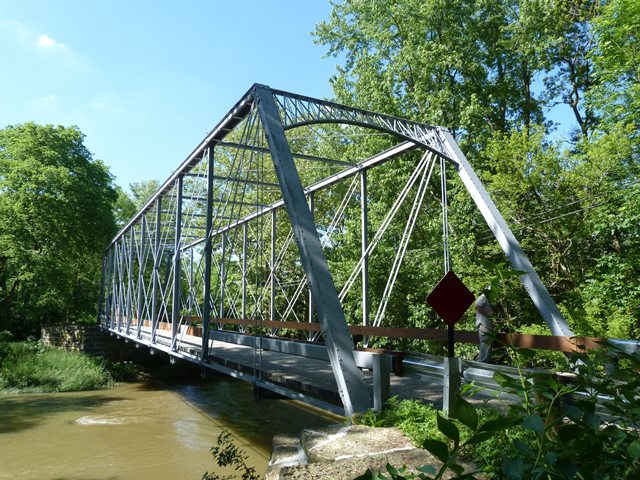We Recommend:
Bach Steel - Experts at historic truss bridge restoration.
Mill Road Bridge

Primary Photographer(s): Nathan Holth and Rick McOmber
Bridge Documented: June 6, 2014
Gettysburg: Darke County, Ohio: United States
Metal 11 Panel Pin-Connected Whipple (Double-Intersection Pratt) Through Truss, Fixed
1881 By Builder/Contractor: Massillon Bridge Company of Massillon, Ohio
1997
132.0 Feet (40.2 Meters)
137.0 Feet (41.8 Meters)
16 Feet (4.88 Meters)
1 Main Span(s)
1945696

View Information About HSR Ratings
Bridge Documentation
View Archived National Bridge Inventory Report - Has Additional Details and Evaluation
This bridge is an amazingly, and largely unaltered example of a Whipple truss. Just as importantly, the bridge is an early example of a bridge by the prolific Massillon Bridge Company. As an early example, the bridge displays a portal bracing with a web composed of pipes arranged as a truss. This use of pipes first showed up in the company's patented bowstring trusses built mostly in the 1870s, and in small Howe trusses, and was also used in portal bracing for a few years in the 1880s before the company stopped using it completely. Also noteworthy are the built-up fishbelly floorbeams which remain on the bridge. Builder plaques are the main thing missing on this bridge.
This bridge has been preserved in place for pedestrian use. It is great to see that Darke County has recognized the historic significance and heritage value of retaining this bridge.
In case you decide to disregard the bollards obstructing the bridge against vehicular traffic, and try to drive something over the bridge, be sure to make sure you don't crash through with anything more than the posted three ton weight limit! Yes, even though the bridge is preserved for pedestrian use, and blocked off with bollards, there is a new 3 ton weight limit sign. Jokes aside, the sign might be in case the bridge needed to be opened to vehicular traffic in an emergency.
Information and Findings From Ohio's Historic Bridge InventorySetting/Context The bridge carries a 1 lane road over a stream in a sparsely developed, rural setting. Fields and woods are to all quadrants. Physical Description The 1 span, 137'-long, pin-connected double-intersection Pratt (Whipple) truss bridge is supported on stone abutments with wingwalls. The bridge is composed of upper chord of toe-out channels with cover plate and battens; built-up verticals of I-beams with cover plates; and diagonals and lower chords of eyebars. The arched lattice portals are composed of bars, pipes, and bolts similar to how this fabricator built-up the arches in its patented bowstring trusses. The built-up fishbelly floorbeams are suspended from the lower-chord pins by U-shaped hangers. Original railings have been removed and replaced with beam guide rails. Integrity Floor replaced in 1979. Railings replaced. The bridge was rehabilitated in 1996-97. Summary of Significance The 1881 truss bridge is a technologically significant example of the double-intersection Pratt thru truss by a prominent Ohio fabricator, the Massillon Bridge Co. (Criterion C). The 1996-97 rehabilitation maintained the integrity of design. Double-intersection Pratt trusses, also known as Whipple or Murphy-Whipple trusses, were among the most successful of long-span thru truss designs (up to 300' long) of the 1860s to 1890s for both railroad and vehicular crossings. Surviving examples are uncommon nationally and considered technologically significant; Ohio with at least 14 identified examples dating from 1881 to 1898 (Phase 1A survey, 2008) has a very high number in comparison to most other states. The truss design is characterized by diagonals that extend over two panels. In 1847, Squire Whipple, one of America's foremost bridge engineers, developed the design figuring that the double-intersection configuration increased the depth of panel without altering the optimal angle of the diagonals, thus allowing for increased span length. His design was further refined in 1859 by John W. Murphy, the talented chief engineer of Pennsylvania's Lehigh Valley RR, who substituted wrought-iron pins for cast-iron connecting pieces, thus developing the connection detail that would prove to be advanced construction practice for this and other truss designs for the next several decades. Ohio's surviving examples, which mostly date to the 1880s, were not cutting edge for their time, but they show how the form had evolved into the preferred long-span thru truss design of the period. Most have documented associations with prominent Ohio-based fabricators. Justification There are 13 examples of the bridge type important to the development and maturation of the pin-connected thru truss bridge. They date from 1881 and concentrate in the 1880s. Even though there are more than 12 extant examples in Ohio, each built in the 1880s has high significance based on overall scarcity (everywhere but in Ohio) of the design. This is a major and technologically significant bridge type. The bridge has high significance. Bridge Considered Historic By Survey: Yes |
![]()
Photo Galleries and Videos: Mill Road Bridge
Bridge Photo-Documentation
Original / Full Size PhotosA collection of overview and detail photos. This gallery offers photos in the highest available resolution and file size in a touch-friendly popup viewer.
Alternatively, Browse Without Using Viewer
![]()
Bridge Photo-Documentation
Mobile Optimized PhotosA collection of overview and detail photos. This gallery features data-friendly, fast-loading photos in a touch-friendly popup viewer.
Alternatively, Browse Without Using Viewer
![]()
Maps and Links: Mill Road Bridge
Coordinates (Latitude, Longitude):
Search For Additional Bridge Listings:
Bridgehunter.com: View listed bridges within 0.5 miles (0.8 kilometers) of this bridge.
Bridgehunter.com: View listed bridges within 10 miles (16 kilometers) of this bridge.
Additional Maps:
Google Streetview (If Available)
GeoHack (Additional Links and Coordinates)
Apple Maps (Via DuckDuckGo Search)
Apple Maps (Apple devices only)
Android: Open Location In Your Map or GPS App
Flickr Gallery (Find Nearby Photos)
Wikimedia Commons (Find Nearby Photos)
Directions Via Sygic For Android
Directions Via Sygic For iOS and Android Dolphin Browser
USGS National Map (United States Only)
Historical USGS Topo Maps (United States Only)
Historic Aerials (United States Only)
CalTopo Maps (United States Only)

